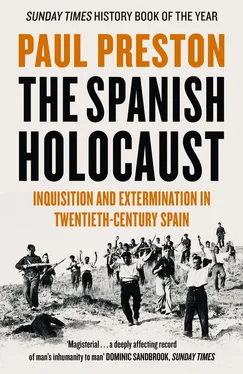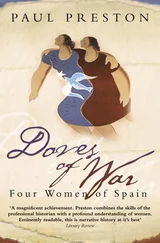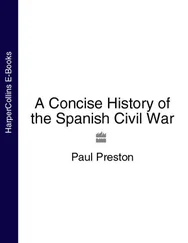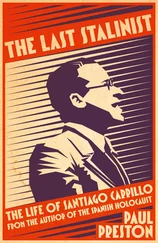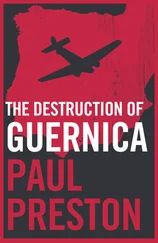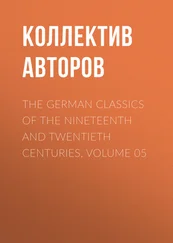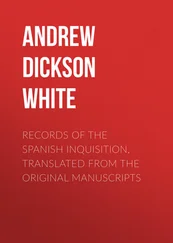Two days later, there took place an incident which played into the hands of the Falange and of the Unión Militar Española. In Madrid’s broad Avenida de la Castellana, there was a military parade to commemorate the fifth anniversary of the founding of the Republic. A loud explosion and the sound of machine-gun fire near the presidential platform alarmed the assembled dignitaries and their police escorts. In fact, the noises came from powerful fireworks placed by Falangists. Then, as the Civil Guard marched past, jeers and chants were heard. These included ‘Down with the Civil Guard!’ and ‘¡UHP!’ (Uníos, Hermanos Proletarios – Unite, Proletarian Brothers), recalling the brutal Asturian repression. Shots were fired and, in the mêlée, a Civil Guard lieutenant in plain clothes, Anastasio de los Reyes López, was fatally wounded by unknown assailants. Subsequently, the left-wing press claimed that he had been shot as a result of a ‘fascist provocation’. Whoever the culprit was, the right was successful in squeezing the greatest advantage from the incident. 74
The government tried to have Reyes buried discreetly but the head of his unit, Lieutenant Colonel Florentino González Vallés, turned the funeral into a massive anti-Republican demonstration. Fernando Primo de Rivera, José Antonio’s brother, met representatives of the UME to discuss the role of Falangists and was told that they were expected to carry guns. Flouting government orders to the contrary, González Vallés, himself a Falangist sympathizer, ordered, in an anti-Republican gesture, that the funeral procession should follow the same route as the 14 April military parade. Despite this illegality, Gil Robles and Calvo Sotelo led the cortège. As it came down the Castellana, several shots were fired at the procession. It is not known if the culprits were leftists or right-wing agents provocateurs. When the Falangists tried to turn the procession into an attack on the Cortes, there was a clash with Assault Guards in which Andrés Sáenz de Heredia, a cousin of José Antonio, was killed. Thereafter, the commander of the Guards, Lieutenant José del Castillo Sáenz de Tejada, received death threats. 75The UME saw the events of 16 April as a boost for recruitment. Prieto commented: ‘Yesterday, it was shown that fascism has taken hold really strongly in our military organizations.’ 76
Disorder was certainly on the increase during the spring of 1936, but its scale was greatly inflated by the right-wing press and in the parliamentary speeches of Gil Robles and Calvo Sotelo, which placed the blame exclusively on the left. However, only two groups stood to benefit, even in theory, from the proliferation of indiscriminate lawlessness – the extreme left of the anarchist movement and the ‘catastrophist’ right who backed military conspiracy. The Popular Front tactic imposed by Moscow meant that Communists had no plans to undermine public order and seize power. In the Socialist Party, both El Socialista, the newspaper of the Prieto wing, and Claridad, the mouthpiece of Largo Caballero, warned their readers to ignore rightist provocation. 77None of the Popular Front parties had any need to provoke violence in order to take power. The creation of an atmosphere of turmoil and disorder could, on the other hand, justify the use of force to establish a dictatorship of the right. It is difficult to distinguish between provocation and reprisal in street fights between Communists or Socialists and Falangists or members of Gil Robles’s youth movement, the JAP. However, it is noteworthy that José Antonio’s close friend Felipe Ximénez de Sandoval boasted that, in the violence following Reyes’s funeral procession, ‘the mortuary welcomed, for every one of ours, ten of theirs’. 78
Significantly, wealthy conservatives who had previously financed Gil Robles to defend their interests were now switching funds to the Falange and the scab union, the Sindicatos Libres. In March, ABC had opened a subscription for a hitherto unknown Federación Española de Trabajadores, behind which could be discerned Ramón Sales, the self-styled fascist agent provocateur who had become famous in the political gangsterism of 1919–23. By late April the fund had reached 350,000 pesetas, donated by aristocrats, landowners, industrialists and many anonymous ‘fascists’ and Falangists. Since the money was never used for trade union purposes and a substantial number of those arrested for acts of violence were members of the Sindicatos Libres, the left had no doubts that this was a fund to finance agents provocateurs. Professional gunmen were being hired by the right and their operations were designed to provoke the widest repercussions. 79
The attacks on Jiménez de Asúa and Largo Caballero were clearly among those aimed at provoking reprisals. The most successful operation of this kind was carried out in Granada on 9–10 March. A squad of Falangist gunmen fired on a group of workers and their families, wounding many women and children. The local CNT, the UGT, the Partido Comunista de España (PCE) and the Partido Sindicalista united in calling a general strike in the course of which there was considerable violence. Two churches and the offices of both the Falange and Acción Popular were set on fire, and the ACNP newspaper, Ideal, was destroyed. Throughout the day, Falangist snipers fired from rooftops on left-wing demonstrators and also on firemen to stop them controlling the fires. In Granada and elsewhere, incidents were often caused by strangers who disappeared as quickly as they had appeared. When the military rebels took power at the beginning of the Civil War, some of the most radical anarchists and Communists in Granada revealed themselves as Falangist agents provocateurs. Throughout Spain, leftist municipal authorities worked hard to maintain order. They were not helped by the fact that conservative members of the judiciary sympathized with Falangist activities. Judges who did take a strong line against rightist gunmen were, in their turn, selected as targets. 80
On 15 April, when Azaña presented his moderate programme of government to the Cortes, Calvo Sotelo declared that any cabinet that relied on PSOE votes was effectively under Russian dominance. Less stridently, Gil Robles produced a masterpiece of hypocrisy. He patronizingly recognized Azaña’s good intentions and denied that the conflictive situation in the countryside owed anything to CEDA policies. Forgetting the humiliation to which Giménez Fernández had been subjected, he claimed that his party was committed to the elimination of social injustice and to the equitable redistribution of wealth. He went on to endorse Calvo Sotelo’s claim that the government was impotent before a wave of disorder caused entirely by the left. Blaming the violence of agents provocateurs on governmental weakness, he said that his followers were already taking up arms in self-defence. He declared that he would soon have to tell them to expect nothing from legality and to join parties that offered them ‘the lure of revenge’. In apocalyptic terms, he issued a dire warning: ‘Half the nation will not resign itself to die. If it cannot defend itself by one path, it will defend itself by another … When civil war breaks out in Spain, let it be known that the weapons have been loaded by the negligence of a government which has not been able to fulfil its duty towards groups which have stayed within the strictest legality.’ He ended with a resounding battle cry: ‘It is better to know how to die in the street than to be trampled on as a coward.’
Gil Robles was effectively threatening war if the Popular Front did not drop its commitment to thorough reform of the social and economic structure. Because parliamentary speeches could not be censored, Gil Robles and Calvo Sotelo larded theirs with exaggerations of disorder. They knew that, reported in full in the press, their predictions of doom would generate an atmosphere of terror among sectors of the middle and upper classes, who would look to the army for salvation. Gil Robles’s remarks in the Cortes of 15 April and his assiduous attendance at the funerals of Falangist gunmen projected the impression that political violence was the exclusive responsibility of the left. Behind his rhetoric of concern for public order, the CEDA was organizing motorized machine-gun assault groups and, as the spring wore on, ever more rightist youths arrested for acts of violence were members of the Juventud de Acción Popular. 81
Читать дальше
